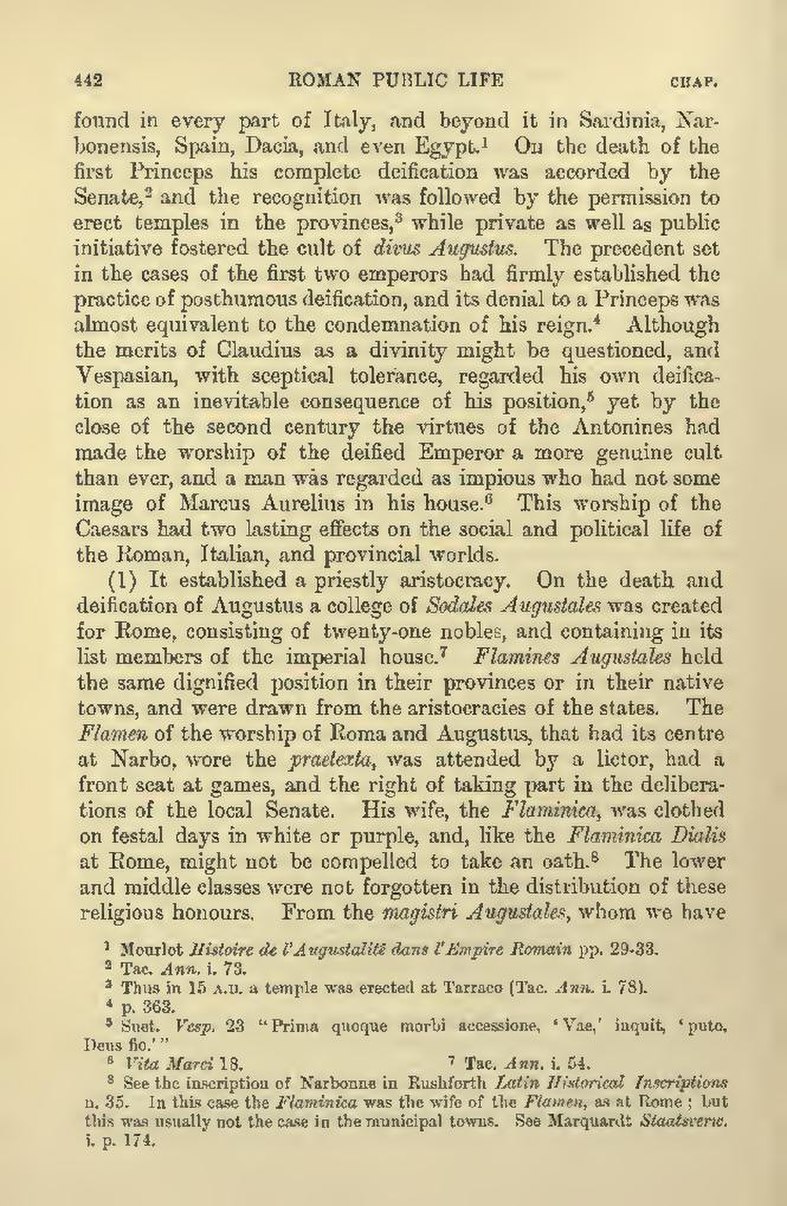found in every part of Italy, and beyond it in Sardinia, Narbonensis, Spain, Dacia, and even Egypt.[1] On the death of the first Princeps his complete deification was accorded by the Senate,[2] and the recognition was followed by the permission to erect temples in the provinces,[3] while private as well as public initiative fostered the cult of divus Augustus. The precedent set in the cases of the first two emperors had firmly established the practice of posthumous deification, and its denial to a Princeps was almost equivalent to the condemnation of his reign.[4] Although the merits of Claudius as a divinity might be questioned, and Vespasian, with sceptical tolerance, regarded his own deification as an inevitable consequence of his position,[5] yet by the close of the second century the virtues of the Antonines had made the worship of the deified Emperor a more genuine cult than ever, and a man was regarded as impious who had not some image of Marcus Aurelius in his house.[6] This worship of the Caesars had two lasting effects on the social and political life of the Roman, Italian, and provincial worlds.
(1) It established a priestly aristocracy. On the death and deification of Augustus a college of Sodales Augustales was created for Rome, consisting of twenty-one nobles, and containing in its list members of the imperial house.[7] Flamines Augustales held the same dignified position in their provinces or in their native towns, and were drawn from the aristocracies of the states. The Flamen of the worship of Roma and Augustus, that had its centre at Narbo, wore the praetexta, was attended by a lictor, had a front seat at games, and the right of taking part in the deliberations of the local Senate. His wife, the Flaminica, was clothed on festal days in white or purple, and, like the Flaminica Dialis at Rome, might not be compelled to take an oath.[8] The lower and middle classes were not forgotten in the distribution of these religious honours. From the magistri Augustales, whom we have
- ↑ Mourlot Histoire de l'Augustalité dans l'Empire Romain pp. 29-33.
- ↑ Tac. Ann. i. 73.
- ↑ Thus in 15 A.D. a temple was erected at Tarraco (Tac. Ann. i. 78).
- ↑ p. 363.
- ↑ Suet. Vesp. 23 "Prima quoque morbi accessione, 'Vae,' inquit, 'puto, Deus fio.'"
- ↑ Vita Marci 18.
- ↑ Tac. Ann. i. 54.
- ↑ See the inscription of Narbonne in Rushforth Latin Historical Inscriptions n. 35. In this case the Flaminica was the wife of the Flamen, as at Rome; but this was usually not the case in the municipal towns. See Marquardt Staatsverw. i. p. 174.
